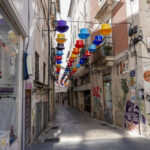Coimbra City Council installs automatic control in streets with conditioned access in Baixa
![[:pt]CM de Coimbra instala controlo automático em ruas com acesso condicionado na Baixa[:en]Coimbra City Council installs automatic control in streets with conditioned access in Baixa[:es]El Ayuntamiento de Coimbra instala un control automático en las calles con acceso acondicionado del centro de la ciudad[:fr]Le conseil municipal de Coimbra installe un contrôle automatique dans les rues à accès conditionné du centre ville[:zh]科英布拉市政厅在市中心有条件通行的街道上安装自动控制装置[:]](https://d1yd5nm87cqjat.cloudfront.net/prod/baixa-coimbra/2025/09/09121916/1757416755-1024x576.jpg)
![[:pt]CM de Coimbra instala controlo automático em ruas com acesso condicionado na Baixa[:en]Coimbra City Council installs automatic control in streets with conditioned access in Baixa[:es]El Ayuntamiento de Coimbra instala un control automático en las calles con acceso acondicionado del centro de la ciudad[:fr]Le conseil municipal de Coimbra installe un contrôle automatique dans les rues à accès conditionné du centre ville[:zh]科英布拉市政厅在市中心有条件通行的街道上安装自动控制装置[:]](https://d1yd5nm87cqjat.cloudfront.net/prod/baixa-coimbra/2025/09/09121916/1757416755-150x150.jpg)

The Coimbra City Council (CM) has invested around half a million euros to install an automatic entry and exit control system for vehicles on streets that already have conditioned car access in the city center. The project is funded by the Recovery and Resilience Plan (PRR) under the “Digital Business Neighborhoods” initiative.
The Coimbra City Council has awarded Soltráfego, following a public tender, the installation of an automatic system to control the entry and exit of vehicles on streets in the city center that already have conditional traffic, for 463,000 euros (plus VAT), according to the contract published last week and consulted by the Lusa agency on the Base public procurement portal.
“These are automatic control systems, with automatic pins that are triggered with a system of readings and license plate recognition,” Coimbra City Council’s mobility councillor, Ana Bastos, told Lusa.
The project, funded under the “Digital Commercial Neighborhoods” initiative, will install ten entry and exit control points on streets that already have conditioned access for residents and shopkeepers (for loading and unloading).
The pins will be installed in Praça 8 de Maio and Portagem (controlling access on Ferreira Borges and Visconde da Luz), as well as in the various streets of Baixinha accessed from Avenida Fernão de Magalhães, after the intersection with the future ‘metrobus’ section (Rua da Louça, Simão de Évora, Padeiras, Adelino Veiga and Largo das Ameias), and Rua da Sota, at the entry point from Portagem.
In addition to covering the central core of Baixinha, there will also be two controls near Rua Corpo de Deus and Rua das Figueirinhas (which goes down to the Santa Cruz café), where there have been “some access problems” to the D. Pedro V Municipal Market. Pedro V through that street, explained councillor Ana Bastos.
According to the councillor, residents and shopkeepers will be invited to sign up to the system, but the municipality already has a list of “many of them”, given the issue of the resident’s card. “There will be a database where the respective license plates will be associated and then the system will automatically read the license plate and open the pin and they can enter,” she explained.
In this first phase and being a system that the municipality is implementing for the first time, the council intends to identify difficulties, constraints and complaints and, as a result, expand the system to other areas.
If the system works, Alta should be the next area to be covered by the installation of the pins, and it could also be implemented “in some residential areas that deserve to be defended when they have a lot of demand, particularly for parking or through traffic”, he said.
Questioned by LUSA about whether this system could help combat the abusive presence of vehicles loading and unloading outside the established hours, the councillor stressed that the aim of the system is to discipline access. “Loading and unloading is controlled and, with this methodology, they can enter exactly at the times that are properly defined, with a maximum time to remain in the area. Whether or not there will be a penalty is something we are still deciding, but there will, in any case, be an initial period of transition, with education,” she said, stressing that this system is not intended to jeopardize economic activity.
For Ana Bastos, the system is intended to turn these streets into “a space for urban enjoyment, with good air quality and where people can circulate safely”. Given that the system will be available 24 hours a day, the municipality has yet to define which department will manage the control center – which will ensure that the pins are opened in the event of a malfunction or failure to read the license plates. Ana Bastos stressed that emergency medical and police vehicles will have a kind of card that will allow them to activate entry at any access point.
LUSA/CM de Coimbra
Photo credits: Coimbra City Council | Marta Costa
